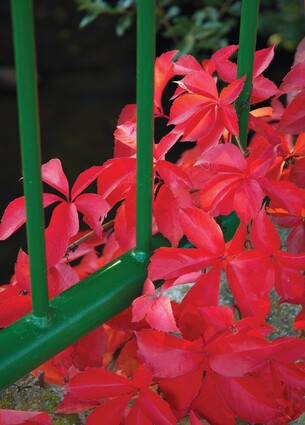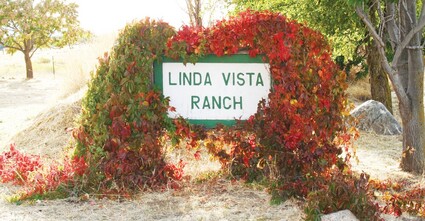A beautiful vine that changes with the seasons
Tehachapi Gardener's Choice
November 11, 2023

Jon Hammond.
Cold nights make the green chlorophyll drain out of Virginia Creeper, turning the leaves red.
One of the hardiest and most ornamental vines you can plant in the Tehachapi Mountains is Virginia Creeper, an attractive plant that is native to the Eastern and Midwestern states. It is found in the wild as far west as Texas and Utah, but grows very well all the way to the Pacific states. It is known for its shiny, five-fingered leaflets that are bright green in spring and summer but then turn brilliant shades of red and burgundy in autumn.
Virginia Creeper is a climber that can reach surprising heights – one vine at the Mourning Cloak Ranch used a giant old Valley Oak as a trellis and could be seen 6o feet up into the tree, cloaking the tree in green during the growing season and then beautiful shades of red in fall.
It is not like a strangler fig that routinely kills trees that it grows on – Virginia Creeper is quite benign and generally does no harm to "trellis trees." It also grows well on masonry or wire fences – at the Harris Ranch restaurant along Interstate 5 near Kettleman City, several miles of wire fence host attractive Virginia Creeper vines.

Jon Hammond.
Virginia Creeper clumps got big a few years ago while growing on our old sign on Cherry Lane.
The plant has tiny adhesive pads on the end of its tendrils, so it is able to adhere to smooth masonry surfaces like buildings without doing any damage to the structures, like many other vines do. There are some old Virginia Creeper vines that have been growing on antique Gold Rush era structures in the Mother Lode region of California for well over a century without harming the buildings.
They provide welcome shade, cooling a structure in the summer, and then they lose their leaves and allow sunlight in during the winter. Virginia Creeper grows well in sunlight or shade, and the berries are a welcome food source for birds in the winter.
Virginia Creeper
Botanical name: Parthenocissus quinquefolia
Perennial
Starting: Transplanted from a container.
Size: Up to 50 feet long (or tall, if provided with trellis or support.
Exposure: Full sun, partial sun or shade.
Watering: Deep watering to get established, infrequent summer watering.




